Last week you read here about the impact that development has had on Lake Tahoe over the last 150 years. The jarring environmental degradation from commercial exploitation and fast-rising tourism alarmed people, and in 1959 Dr. Charles Goldman formed the Tahoe Research Group to begin studying and monitoring the lake.
That effort has proven to be particularly valuable because it’s given us insight into how climate change is affecting the lake. Goldman’s group evolved into UC Davis’ terrific Tahoe Environmental Research Center, which assesses the lake using many types of instruments and produces an annual State of the Lake Report based on those findings and accompanying research.
In this week’s blog post, I summarize aspects of the most recent report that reflect how climate change is impacting the lake. You will learn about annual trends as well as specific effects in 2021 that the report says “are among the largest and most significant that have been observed in the 54-year data record”.
Starting with the basics -- the climate is getting warmer. As you can see in the graphs below, average air temperature has gone up by 2.25 F in the last 110 years (shown in orange), and the minimum temperature has gone up by 4.5 F (shown in blue). The average minimum temperature is now above freezing, which means less snow and earlier snowmelt.
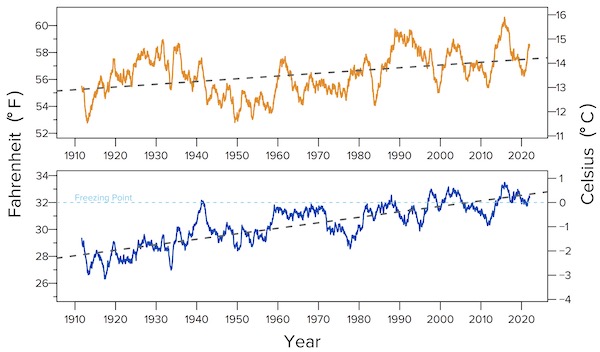
Average temperatures in the Basin have gone up by 2.25 F since 1910 (orange), and minimum temperatures have gone up by 4.5 F (blue). Source: State of the Lake 2022
Looked at another way, the number of days where the average temperature is below freezing has dropped from around 80 in 1911 to around 50 in 2021. Effectively, winter is 29 days shorter. As a result, there is less snow in the Tahoe Basin because more precipitation is falling as rain. The fraction of precipitation falling as snow has dropped from 52% in 1910 to 33% today. Snowmelt is also happening earlier (16 days earlier since 1961).
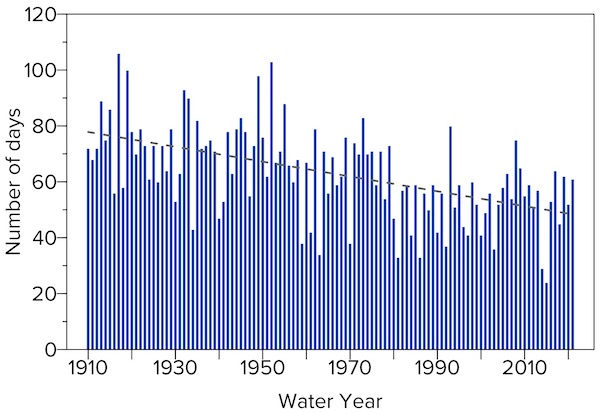
The number of days when the average temperature is below freezing has dropped 29 days in the last 110 years. Source: State of the Lake 2022
As the air gets warmer, the lake also gets warmer. As you can see in the chart below, the water has warmed 1.1 F since 1970.
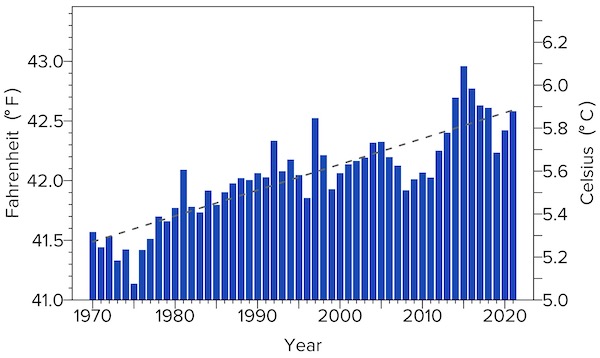
The water in Lake Tahoe is getting warmer. Source: State of the Lake 2022
This is happening not only at the surface but also in the depths of Lake Tahoe, shown below at 400 meters, well below the average depth of 300 meters. The vertical dashed lines indicate “deep mixing” events, when surface waters mix with deeper waters. They can cause heat to leave the lake.
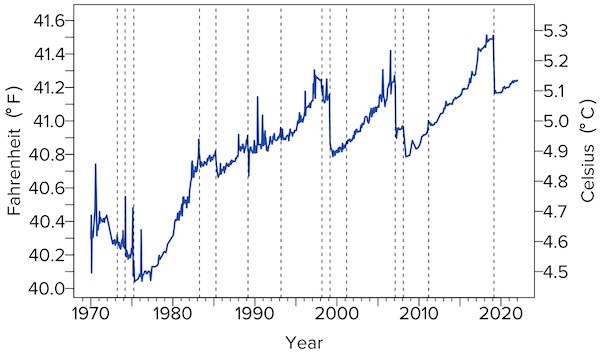
Even water at a depth of 400 meters is getting warmer. Source: State of the Lake 2022
So the air is getting warmer and the water is getting warmer. One result of this, and in particular of the very warm surface waters of the lake, is that the lake doesn’t “mix” as well or as often. Lake mixing normally happens in winter as the surface waters cool and sink downward. Mixing brings oxygen downwards, promoting aquatic life at many depths, and it can help to clear away algae that has formed near the surface. But when the surface waters are very warm, it is harder for the lake to mix.
This chart shows that the lake has gotten “more stable” (a bad thing) by 13.4% in the last 53 years.
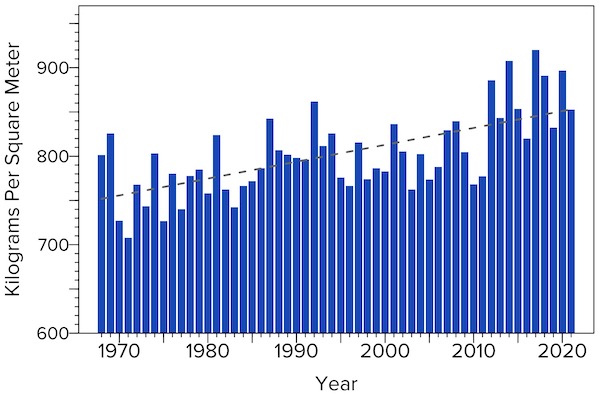
It has gotten harder for the lake levels to mix as the surface waters have warmed. This graph shows “lake stability”, a measure of the energy required to mix the water. Source: State of the Lake 2022
Because winter is effectively shorter now, the lake remains unmixed for longer periods. Summer in the lake (by this metric) is 31 days longer than it was in 1968.
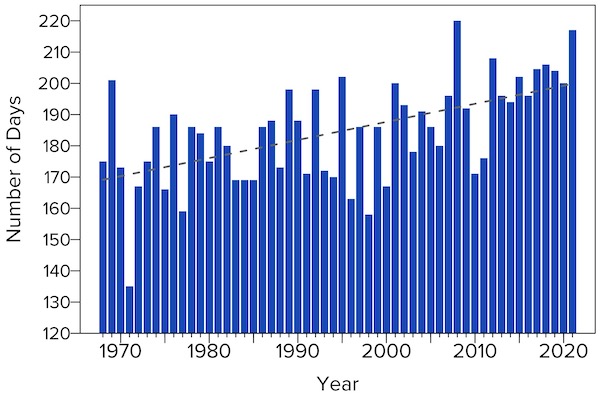
The lake is remaining unmixed for longer periods of time, now 31 days longer than in 1968. Source: State of the Lake 2022
The warmer temperatures and more stratified lake are the result of our warming climate. You can also see that precipitation is becoming more variable, with more periods of drought and more periods of intense precipitation.
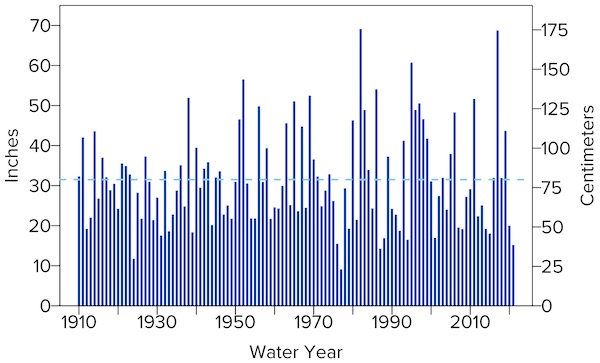
Precipitation at Lake Tahoe is highly variable year to year, and more so over the last 40 years. Source: State of the Lake 2022
The drought years drain the lake, as shown in the graph below. There is a minimal bump in the spring of drought years due to reduced snowmelt. Lake level dropped about 5 feet in the last three years of drought (October 2019 to October 2022). The stormy years in turn should replenish the lake. With a wetter year this year, the lake level has already bounced back over a foot and hopefully will be even higher by the end of the water year (end of September). These changing lake levels can cause erosion and disrupt shoreline and nearshore habitat.
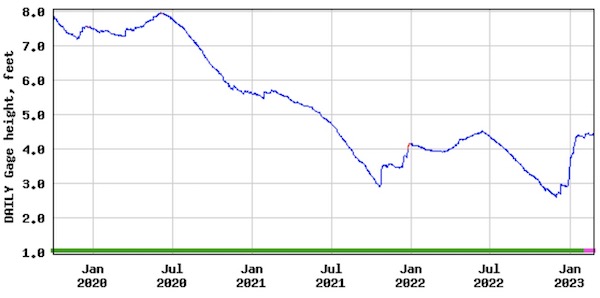
Lake Tahoe’s level dropped during the recent multi-year drought, dropping below its natural rim of 6223 feet at the end of autumn last year. But it is beginning to rebound with more precipitation this year. Source: USGS
Climate change affects lake clarity. The warmer temperatures and more stratified lake can decrease lake clarity, as can increased sediment from wildfires. But drought can improve lake clarity since there is less sediment from runoff and erosion.
In practice, lake clarity has grown worse since 1968. It used to be that you could see a white disk clearly at 100 feet below the water. Now it disappears at 60-70 feet. (Higher disks represent murkier water in the graph below.) Clarity seemed to be leveling off, but recent readings are some of the worst on record, even in drought years when clarity should be better.
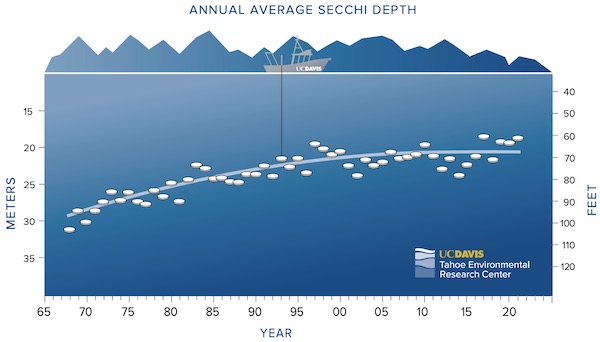
Lake clarity has worsened over the years. (A disk that can be seen at greater depth means better clarity.) Source: State of the Lake 2022
The State of the Lake Report doesn’t seem to explicitly track the incidence of fire and its impact on forest cover or air quality, which are worsened by climate change. But it does report some of the impacts of the smoke and sediment on the lake after three fires spewed smoke into the basin in summer and fall of 2021. The phytoplankton in the lake were dramatically impacted. For the first time, they were dominated by a species of cyanobacteria that thrives on the high Nitrogen:Phosporus ratio that comes from wildfire smoke.
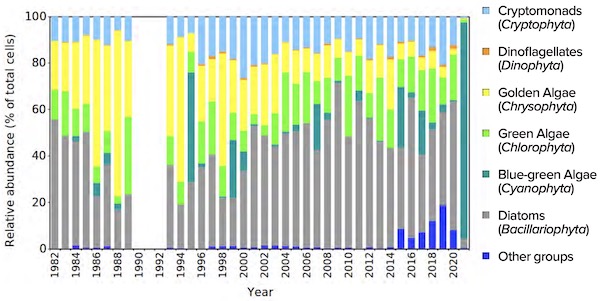
In 2021, for the first time since these assessments have been done, the lake’s phytoplankton were dominated by a single species, a type of cyanobacteria. Source: State of the Lake 2022
Researchers also noticed that chlorophyll-producing algae (shown in yellow below) moved to shallower levels of the lake in the fall, perhaps as a result of wildfire blocking out the sun.

Chlorophyll-producing algae moved up towards the surface of the lake in fall of 2021 for the first time since these observations have been made. Source: State of the Lake 2022
These recent changes are unprecedented in the observed history of the lake, and it remains to be seen how the lake and its aquatic residents will react. Climate change is altering many aspects of the environment in the Tahoe Basin and the ecosystems are necessarily responding and adapting. It is a very dynamic situation and I am glad that the Tahoe Environmental Research Center is tracking these changes and their effects on the lake. I only wish there were similar reports on the forests, meadows, and wetlands of the region.
Notes and References
1. The report noted some other recent changes, including the (presumed temporary) disappearance of the introduced Mysis shrimp, considerable new algal growth, and the discovery of large amounts of microplastics. Since these changes are not clearly related to climate change, I have left them out of this blog post.

Algae biomass has grown six-fold in the last 50 years. A number of things can impact this, such as the amount of nutrients in the lake, the amount of light, and the types of algal species. Source: State of the Lake 2022
On the good news front, the disappearance of the Mysis shrimp, even if temporary, could result in much improved lake clarity, since the native Daphnia are expected to become more populous with no Mysis around. These tiny zooplankton can consume 100,000 fine particles every hour!
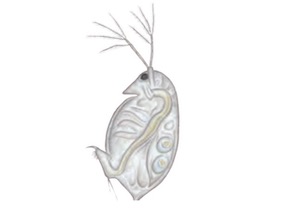
Sketch of a native Daphnia, or common water flea. These are much smaller than pictured, about 0.2 to 6.0 mm in length. Source: State of the Lake 2022
Current Climate Data (January 2023)
Global impacts, US impacts, CO2 metric, Climate dashboard

Climate Stripes. Source: University of Reading
Comment Guidelines
I hope that your contributions will be an important part of this blog. To keep the discussion productive, please adhere to these guidelines or your comment may be edited or removed.
- Avoid disrespectful, disparaging, snide, angry, or ad hominem comments.
- Stay fact-based and refer to reputable sources.
- Stay on topic.
- In general, maintain this as a welcoming space for all readers.



